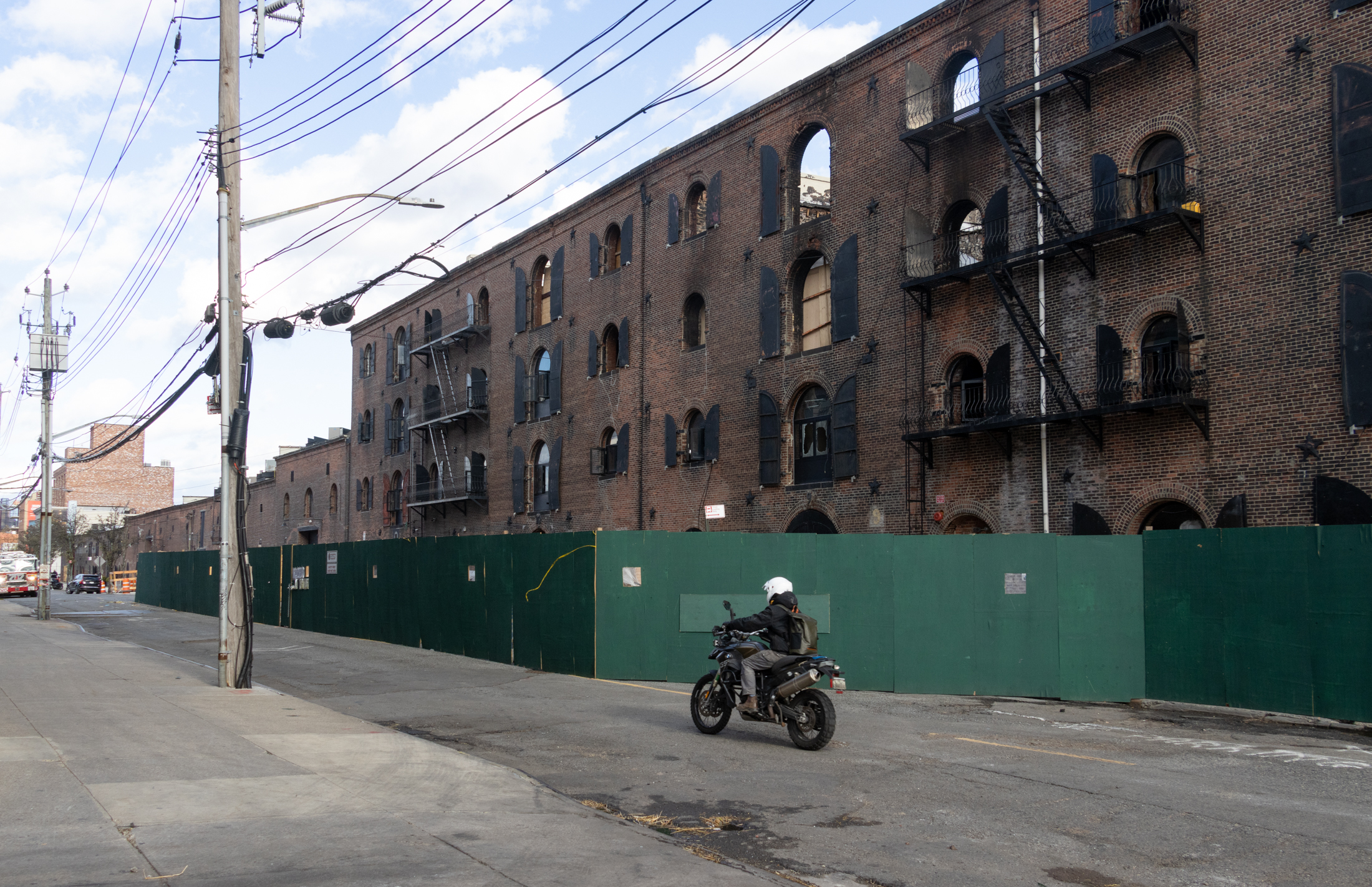Inside the Beautiful Astoria Church, Saint Demetrios Cathedral
The Saint Demetrios Cathedral on 31st Street here in Astoria holds an annual street fair in the late spring, and last year I had an opportunity to enter the church and wave my camera around a bit. Greek, or Eastern Orthodox as the faithful would prefer, churches are a particular favorite of mine to visit…


The Saint Demetrios Cathedral on 31st Street here in Astoria holds an annual street fair in the late spring, and last year I had an opportunity to enter the church and wave my camera around a bit. Greek, or Eastern Orthodox as the faithful would prefer, churches are a particular favorite of mine to visit and photograph due to the literally byzantine artwork and wealth of lavish ornamentation.
From saintdemetriosastoria.com:
Saint Demetrios was born in Thesaloniki, Greece in 270 AD. He came from a wealthy family and because he was athletic in appearance and heroic in spirit, he became a high-ranking officer in the Roman Army at a very young age. (This is why he is depicted in Byzantine icons in military dress, either standing or riding a horse.) He considered himself a soldier of Christ first, and a military soldier second. He spent most of his time as a devout missionary, preaching the Gospel at secret meetings and converting pagans to the Christian faith.

As a note – Every time that I do a posting about a church, someone invariably accuses me of being ignorant or attempting to smear an institution somehow. The ignorance thing I gladly ‘fess up to, and hope that someone in the know will be prompted to share their knowledge with me and the rest of you, but “smear”? Seriously, this accusation could not be further from the truth, as the last thing I want to argue with anyone about is religion. Politics yes, but religion no.
Funnily enough, the Greeks pretty much invented both politics and religion, and probably “arguing” as well. If there’s something that modern humans do, it was probably a Hellene that did it first.
Also from saintdemetriosastoria.com:
The very first organized meeting of Greeks included also the residents of Corona and took place on December 18, 1923 at the Archdiocese which was then located on 30th Drive in Astoria. Immediately following these few Greek families received permission from the then, Archbishop Rodostolou to attend services in the Archdiocesan chapel of St. Athanasios on 30th Drive. At that time, the first Greek School was established.
The people then felt a need to organize their own Church and in 1927 the ground on which St. Demetrios stands today, was purchased for $3,500. An architect was engaged and a $25,000 structure was agreed upon which could later serve as a basement for the someday completed structure of their dream.

I wasn’t entirely sure if it was ok to be taking pictures in the Cathedral, and an older Hellenic woman was watching me carefully. If you don’t know any older Hellenic women, trust me on this, you don’t want them angry at you.
It ends badly.
The lady, however, did not adjure me to cease photographing, so I kept on clicking. A Priest latter assured me that it was cool, and he directed my attentions to the windows.
From holy-ny.com:
In terms of architectural style, the building itself is reminiscent of older Byzantine churches. Its high arching stained glass windows are also reflective of a distinctly American style. Greek characters adorn each wall, and flags of Greece stand tall throughout.
The church offers a variety of different services, ranging from blessing a new office or home to holding services for those about to go to war. Funeral services are also provided, as well as exorcisms.

A lovely stained glass window dominates the cathedral, depicting the annunciation. The young priest whom I encountered described the windows as being the work of a famous Greek artist and that it was a great coup for this congregation to possess them, however I can supply little additional details on the artist.
From Wikipedia:
In Eastern Christianity Mary is referred to as Theotokos (Θεοτόκος=”God-bearer”). The traditional Troparion (hymn for the day) of the Annunciation which goes back to Saint Athanasius of Alexandria is:
Today is the beginning of our salvation,
And the revelation of the eternal mystery!
The Son of God becomes the Son of the Virgin
As Gabriel announces the coming of Grace.
Together with him let us cry to the Theotokos:
“Rejoice, O Full of Grace, the Lord is with you!”
The Feast of the Annunciation is one of the twelve Great Feasts of the church year. As the action initiating the Incarnation of Christ, Annunciation has such an important place in Eastern theology that the Festal Divine Liturgy of St. John Chrysostom is always celebrated on March 25, regardless of what day it falls on—even if it falls on Pascha (Easter Sunday) itself, a coincidence which is called Kyriopascha. The only time the Divine Liturgy may be celebrated on Great and Holy Friday is if it falls on March 25. Due to this, the rubrics regarding the celebration of the feast are the most complicated of all in Eastern liturgics. The Annunciation is called Euangelismos (Evangelism) in Greek, literally meaning “spreading the Good News.”

In 2007, the Saint Demetrios congregation was robbed of a relic of the saint himself, which was later returned. While looking around for information on the Saint – I became interested in Myrrh, a term I’ve heard all my life but have never been quite sure what it meant. A sort of tree resin, I’m told it is used extensively by both Catholic and Orthodox churches for incense and other ritual usage.
Having grown up in the Jewish culture, such usage of resinous incense wasn’t part of the program, as we had pastrami.
From nytimes.com:
Detectives in Queens have cracked the case of a stolen church reliquary, the police said.
The reliquary — a sterling silver box containing a saint’s ankle bone — was stolen from the solea, a sanctuary platform, in front of the altar of St. Demetrios Greek Orthodox Cathedral in Astoria between noon and 2 p.m. on Tuesday, the police said. Church elders discovered the theft early on Wednesday, during morning prayers, said Fr. Dionysios Anagnostopoulos, who is the church’s archimandrite, a clerical dignitary ranking below a bishop.

Informal and entirely incidental reading has suggested to me that both Myrrh and Frankincense were a standard carry for soldiers in the Roman military serving in the theaters of North Africa and the Near East.
In a world without antibiotics, the two substances were used to treat wounds incurred in the field.
From Wikipedia:
One theory is that his veneration was transferred from Sirmium when Thessaloniki replaced it as the main military base in the area in 441/442 AD. His very large church in Thessaloniki, the Hagios Demetrios, dates from the mid-5th century, so he clearly had a large following by then. Thessaloniki remained a centre of his veneration, and he is the patron saint of the city.
After the growth of his veneration as saint, the city of Thessaloniki suffered repeated attacks and sieges from the Slavic peoples who moved into the Balkans, and Demetrius was credited with many miraculous interventions to defend the city. Hence later traditions about Demetrius regard him as a soldier in the Roman army, and he came to be regarded as an important military martyr. Unsurprisingly, he was extremely popular in the Middle Ages, and along with Saint George, was the patron of the Crusades.
Newtown Creek Alliance Historian Mitch Waxman lives in Astoria and blogs at Newtown Pentacle.





What's Your Take? Leave a Comment